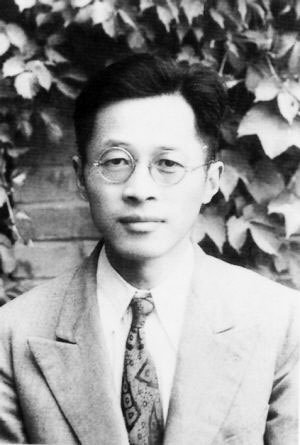Wang, Ganchang
Enlarge text Shrink text- Wang, C. Wu li hsueh ming ... 1961
- Wang Kan-chang ho ta ti ko hsueh ... 1987:p. 269, etc. (b. 5/28/1907; a physicist)
- Zhui qiu zhuo yue, 1999:t.p. (Wang Ganchang) p. (d. 12-10-1998)
Wang Ganchang (Chinese: 王淦昌; pinyin: Wáng Gànchāng; Wade–Giles: Wang Kan-ch'ang; May 28, 1907 – December 10, 1998) was a Chinese nuclear physicist. He was one of the founding fathers of Chinese nuclear physics, cosmic rays and particle physics. Wang was also a leader in the fields of detonation physics experiments, anti-electromagnetic pulse technology, nuclear explosion detection, anti-nuclear radiation technology, and laser stimulated nuclear explosion technologies. For his numerous contributions, Wang is considered among the top leaders, pioneers and scientists of the Chinese nuclear weapons program. He was elected a member of the Chinese Academy of Sciences, and was a member of the Chinese Communist Party. In 1930, Wang first proposed the use of a cloud chamber to study a new type of high-energy ray induced by the bombardment of beryllium with α particles. In 1941 Wang first proposed the use of beta-capture to detect the neutrino. James Allen employed his suggestion and found evidence for the existence of the neutrino in 1942. Frederick Reines and Clyde Cowan detected the neutrino via the inverse beta-decay reaction in 1956, for which, forty years later, Reines was awarded the 1995 Nobel Prize in Physics. Wang also led a group which discovered the anti-sigma minus hyperon particle at the Joint Institute for Nuclear Research, Dubna, Russia in 1959. After May 1950, Wang became researcher and vice-director of the Institute of Modern Physics. He was also vice-director of the Soviet Joint Institute for Nuclear Research. From spring of 1969 onwards, Wang held many high-level positions within Chinese academic and political organizations. He was vice-director of the Ninth Research Institute (二机部第九研究院), predecessor of the China Academy of Engineering Physics, director of the China Institute of Atomic Energy, deputy director of the Nuclear industry Science and Technology Commission (核工业部科技委), and second vice-chairman of the China Association for Science and Technology. He was also vice-chairman of the Chinese Physical Society and the first chairman of the Chinese Nuclear Society. Within the political sphere he was a member of the 3rd through 16th National People's Congress Standing Committees of the Chinese government. In 2000, the Chinese Physical Society established five prizes in recognition of five pioneers of modern physics in China. The Wang Ganchang Prize is awarded to physicists in particle physics and inertial confinement fusion.
Read more on Wikipedia >
 Personality
Personality



